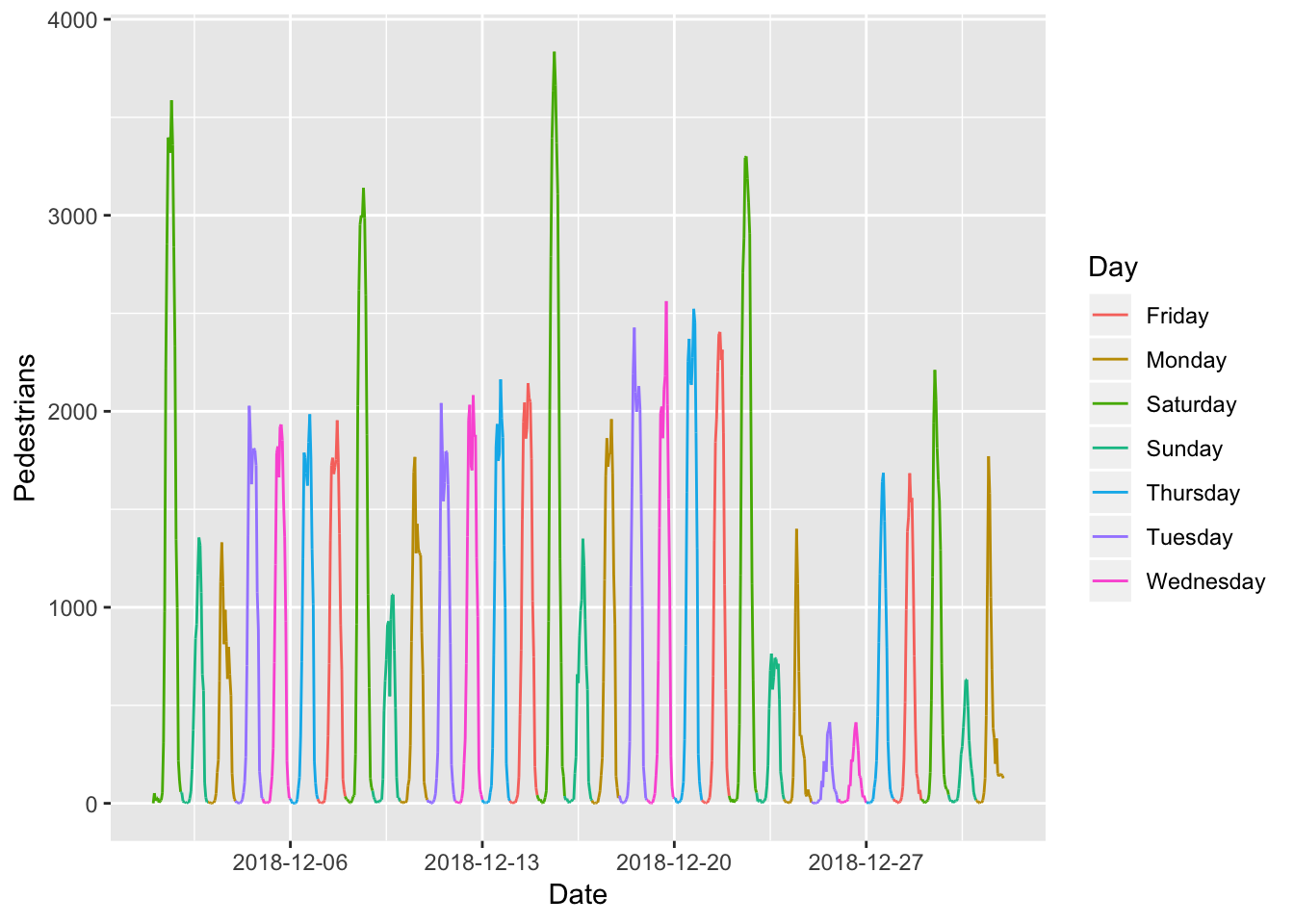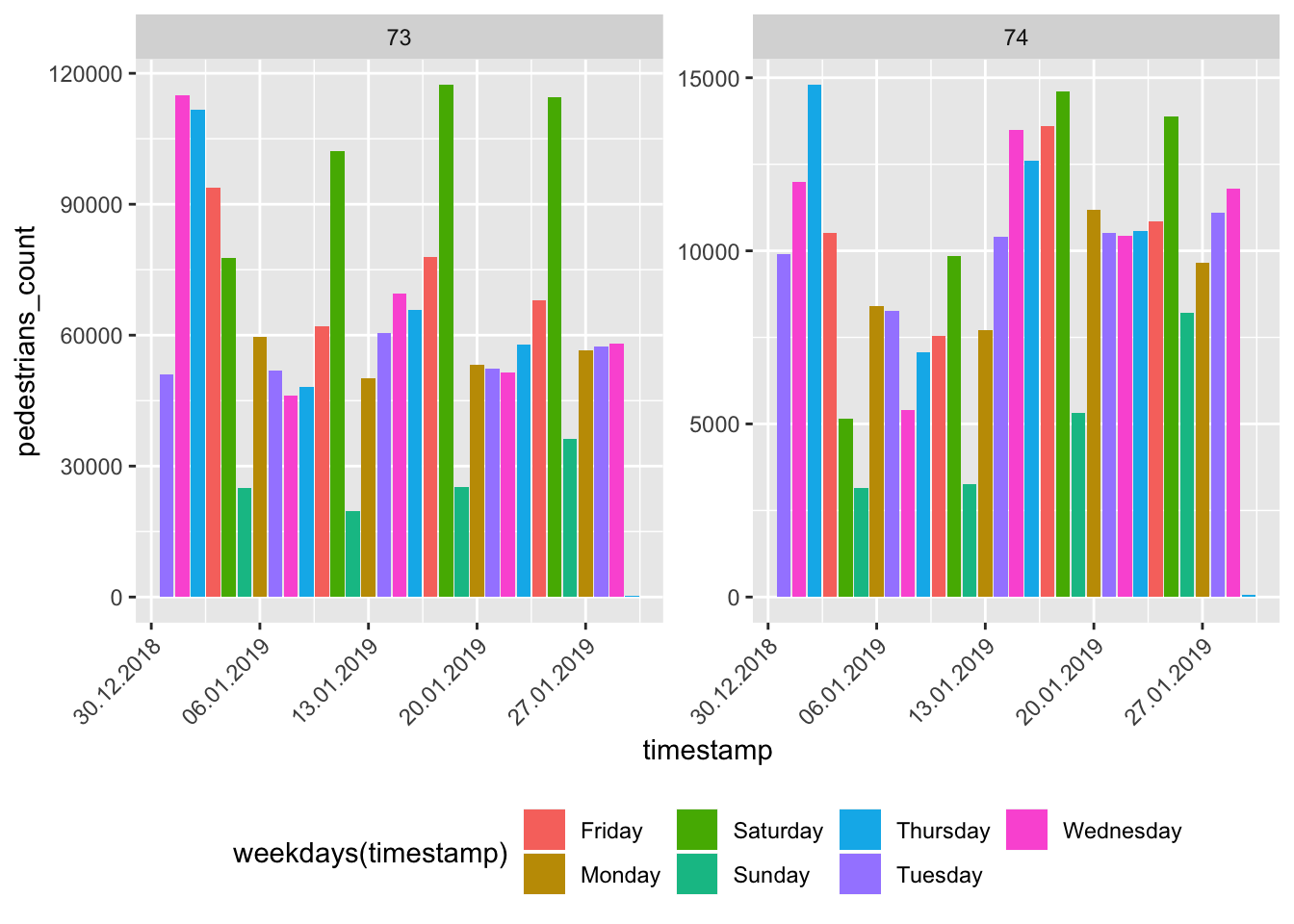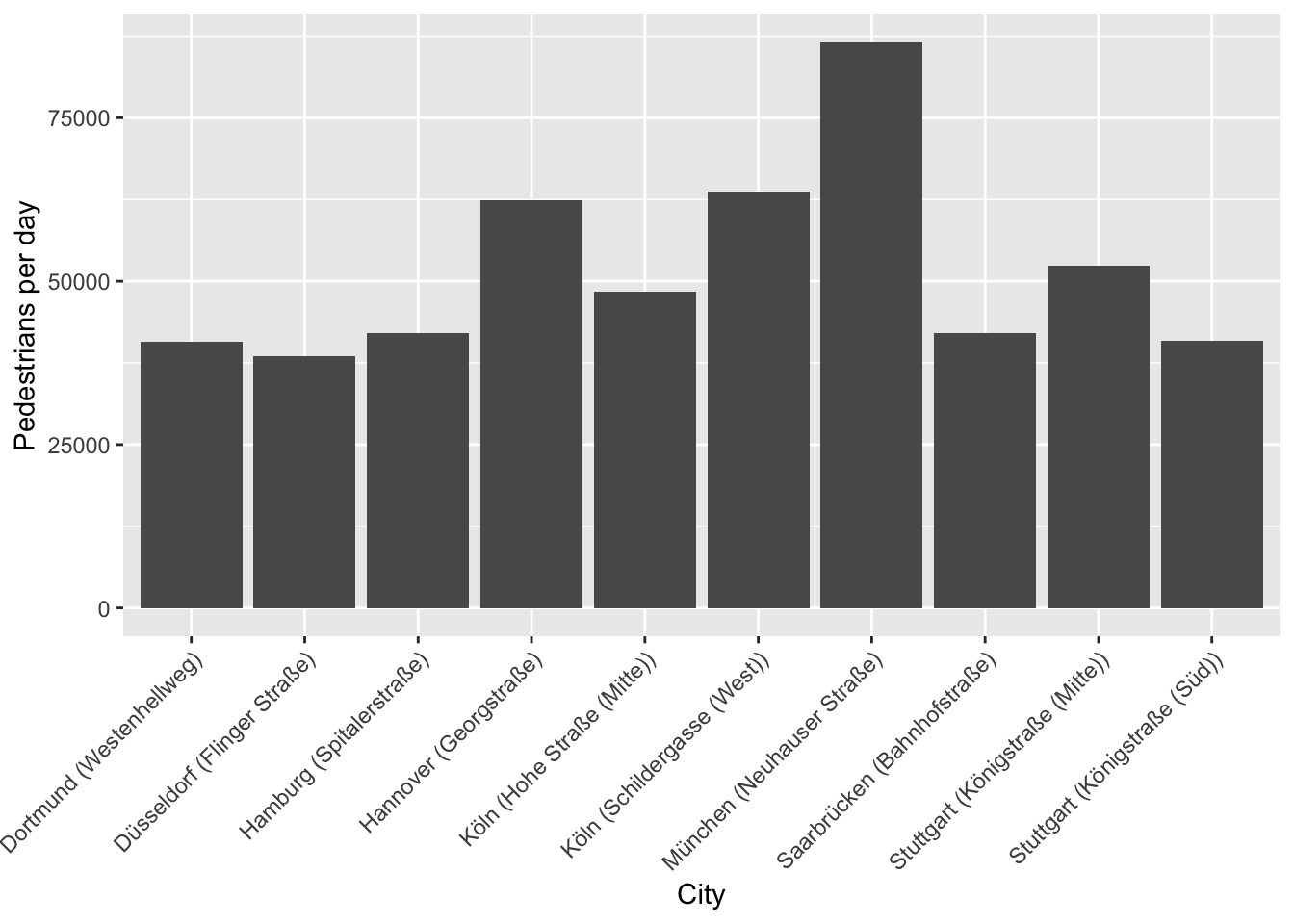hystreet is a company collecting pedestrains in german cities. After registering you can download the data for free from 19 cities.
Until now the package is not on CRAN but you can download it via GitHub with the following command:
if (!require("devtools"))
install.packages("devtools")
devtools::install_github("JohannesFriedrich/hystReet")To use this package, you will first need to get your hystreet API key. To do so, go to this link: https://hystreet.com/
Now you have three options:
Once you have your key, save it as an environment variable for the current session by running the following:
Sys.setenv(HYSTREET_API_TOKEN = "PASTE YOUR API TOKEN HERE")- Alternatively, you can set it permanently with the help of
usethis::edit_r_environ()by adding the line to your.Renviron:
HYSTREET_API_TOKEN = PASTE YOUR API TOKEN HERE
- If you don’t want to save it here, you can input it in each function
using the
API_tokenparameter.
| Function name | Description | Example |
|---|---|---|
| get_hystreet_stats() | request common statistics about the hystreet project | get_hystreet_stats() |
| get_hystreet_locations() | request all qvailable locations | get_hystreet_locations() |
| get_hystreet_station_data() | request data from a stations | get_hystreet_station_data(71) |
| set_hystreet_token() | set your API token | set_hystreet_token(123456789) |
The function ‘get_hystreet_stats()’ summarises the number of available stations and the sum of all counted pedestrians.
library(hystReet)
## Loading required package: httr
## Loading required package: jsonlite
##
## Attaching package: 'jsonlite'
## The following object is masked from 'package:purrr':
##
## flatten
stats <- get_hystreet_stats()stats|
stations |
counts |
|---|---|
|
55 |
352970219 |
The function ‘get_hystreet_locations()’ requests all available stations of the project.
locations <- get_hystreet_locations()locations|
id |
name |
city |
|---|---|---|
|
53 |
Schadowstraße (West) |
Düsseldorf |
|
114 |
Herrenteichsstraße (Ost) |
Osnabrück |
|
94 |
Kurfürstendamm Südseite (Ost) |
Berlin |
|
103 |
Schuchardstraße |
Darmstadt |
|
108 |
Große Straße (Mitte) |
Osnabrück |
|
68 |
Petersstraße |
Leipzig |
|
95 |
Planken (Mitte) |
Mannheim |
|
107 |
Krahnstraße (Süd) |
Osnabrück |
|
54 |
Schadowstraße (Ost) |
Düsseldorf |
|
109 |
Krahnstraße (Mitte, Altstadt) |
Osnabrück |
The (properly) most interesting function is ‘get_hystreet_station_data()’. With the hystreetID it is possible to request a specific station. By default, all the data from the current day are received. With the ‘query’ argument it is possible to set the received data more precise: * from: datetime of earliest measurement (default: today 00:00:00:): e.g. “10-01-2018 12:00:00” or “2018-10-01” * to : datetime of latest measurement (default: today 23:59:59): e.g. “12-01-2018 12:00:00” or “2018-12-01” * resoution: Resultion for the measurement grouping (default: hour): “day”, “hour”, “month”, “week”
data <- get_hystreet_station_data(
hystreetId = 71,
query = list(from = "01-12-2018", to = "31-12-2018", resolution = "day"))Let´s see if we can see the most frequent days before christmas … I think it could be saturday ;-). Also nice to see the 24th and 25th of December … holidays in Germany :-).
data <- get_hystreet_station_data(
hystreetId = 71,
query = list(from = "01-12-2018", to = "01-01-2019"))ggplot(data$measurements, aes(x = timestamp, y = pedestrians_count, colour = weekdays(timestamp))) +
geom_path(group = 1) +
scale_x_datetime(date_breaks = "7 days") +
labs(x = "Date",
y = "Pedestrians",
colour = "Day")Now let´s compare different stations:
- Load the data
data_73 <- get_hystreet_station_data(
hystreetId = 73,
query = list(from = "01-01-2019", to = "31-01-2019", resolution = "day"))$measurements %>%
select(1:2) %>%
mutate(station = 73)
data_74 <- get_hystreet_station_data(
hystreetId = 74,
query = list(from = "01-01-2019", to = "31-01-2019", resolution = "day"))$measurements %>%
select(1:2) %>%
mutate(station = 74)
data <- bind_rows(data_73, data_74)ggplot(data, aes(x = timestamp, y = pedestrians_count, fill = weekdays(timestamp))) +
geom_bar(stat = "identity") +
scale_x_datetime(labels = date_format("%d.%m.%Y")) +
facet_wrap(~station, scales = "free_y") +
theme(legend.position = "bottom",
axis.text.x = element_text(angle = 45, hjust = 1))Now a little bit of big data analysis. Let´s find the station with the highest pedestrians per day ratio:
hystreet_ids <- get_hystreet_locations()
all_data <- lapply(hystreet_ids[,"id"], function(x){
temp <- get_hystreet_station_data(
hystreetId = x)
lifetime_count <- temp$statistics$lifetime_count
days_counted <- as.numeric(temp$metadata$latest_measurement_at - temp$metadata$earliest_measurement_at)
return(data.frame(
id = x,
station = paste0(temp$city, " (",temp$name,")"),
ratio = lifetime_count/days_counted))
})
ratio <- bind_rows(all_data)What stations have the highest ratio?
ratio %>%
top_n(5, ratio) %>%
arrange(desc(ratio))
## id station ratio
## 1 73 München (Neuhauser Straße) 86538.62
## 2 47 Köln (Schildergasse (West)) 63698.54
## 3 63 Hannover (Georgstraße) 62319.37
## 4 77 Stuttgart (Königstraße (Mitte)) 52406.47
## 5 48 Köln (Hohe Straße (Mitte)) 48382.38Now let´s visualise the top 10 cities:
ggplot(ratio %>%
top_n(10,ratio), aes(station, ratio)) +
geom_bar(stat = "identity") +
labs(x = "City",
y = "Pedestrians per day") +
theme(legend.position = "bottom",
axis.text.x = element_text(angle = 45, hjust = 1))

